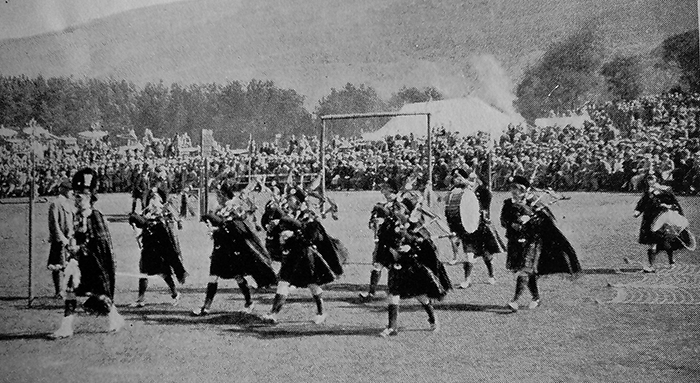
Reading Duncan Watson’s article on the Australian Ladies’ visit reminded me that I had a couple of very old cuttings about them from the Campbeltown Courier.
There’s information that intimates their visit, followed by a fairly comprehensive report on it. I have copied the reporter’s scripts to the letter for authenticity, though some wording is a bit quaint.
By Iain Duncan
The first cutting from the Courier, dated October 9, 1926, reads: The visit of the Australian Ladies Pipe Band to Campbeltown on Saturday first, is an event that is sure to create lively interest. The band is touring Argyllshire this week, giving performances at various centres from the furthest north to the furthest south of the county.
They travel overland to Campbeltown, and their travel here by bus will be awaited with interest. On Saturday night the band, as a combination, and its members individually, will give an entertainment in the Victoria Hall, which commences at eight o’clock.
The programme is of a popular order, comprising selections by the band, bagpipe solos, step dances, vocal solos, recitations, etc. The band, it may be recalled, was first organised to assist soldiers’ charities in Australia during the war.
Its present tour of England, Ireland, Wales and France has been a great success so far. The band is under Drum-Major Wm. Darwin FRGS, and Pipe-Major Dolly McPherson.
The second cutting dated October 16, 1926 reads:
Visit of Australian Ladies Pipe Band – The Australian Ladies Pipe Band, which is now on a tour for educational purposes, paid a visit to Campbeltown last Saturday, and gave an entertainment in the Victoria Hall, to which they attracted a full house.
The band had performed at Tarbert on the previous night, and travelled south overland. They enjoyed their experience along the storm-tossed west coast of Kintyre, the sight of wind and waves in fury giving a wild grandeur to the scene.
The party received a very cordial welcome. They are still minus one of their number, Drum-Sergeant Florrie Yates, who sustained severe head injuries in the motor accident near Glasgow (in which Mr RG Lawrie and two others were killed) not having recovered sufficiently to rejoin the Band.
The playing of the full band was very sweet indeed, and gave great pleasure to the audience. A varied programme entirely sustained by members of the band, provided an excellent entertainment, apart altogether from the novelty and romance of the visit of the enterprising company from under the Southern Cross.
The programme included selections by the band, Highland Reels by Pipe-Major Dolly McPherson, Pipers Gertie Oliver, Tilly Wyatt, and Mary Jack, pipe solos by Pipe-Major Dolly McPherson and Pipe-Sergeant Ailsa Buchanan, dances by Piper Gertie Oliver, the champion Highland dancer of Australia: monologues by Drum-Corporal Laura Bate, A.N.A. Champion, an exhibition of staff swinging by Drum-Major William Darwin, FRGS.: and songs by Drummer Molly Innes, Piper Flora Ash and Drum-Major Darwin.
It is interesting to note that some of the vocal numbers are the original compositions of Drum-Major Darwin, these being ‘Just a Sprig of Golden Wattle’, ‘Scotland and England in Australia’, ‘Hurrah for Australia’.
The band left on Monday, being due at Rothesay the same night to give a performance. On finishing their Scottish tour they go to Ireland and then to France, prior to returning to Australia.


















I looked out the piece that Jeannie Campbell researched and wrote about The Australian Ladies Pipe Band and the history which of course is in terms of 100 years ago is really interesting in many ways. The band would have been developed after WW1 and the after effects of the conflict would have still been causing hurt. The efforts to raise money and then go on a world tour was adventurous and those involved must have been motivated beyond imagination. Things were so different back then and they were living in austere times and people were experiencing real hardship. People of that era were probably more resilient than what we are nowadays. It is humbling to read.